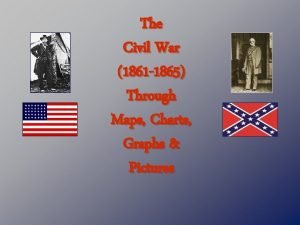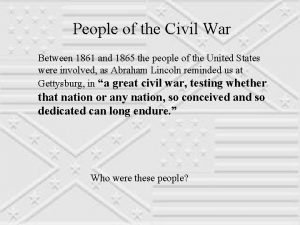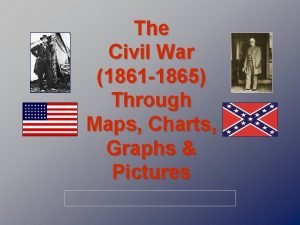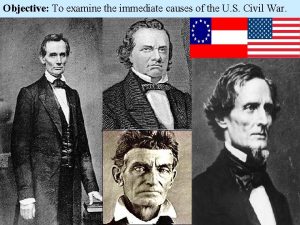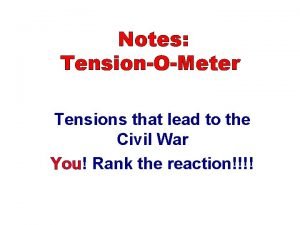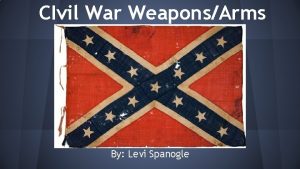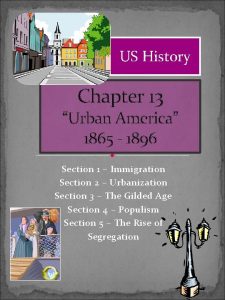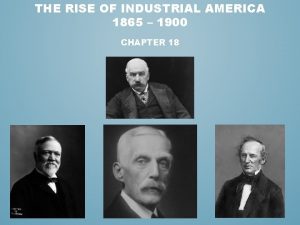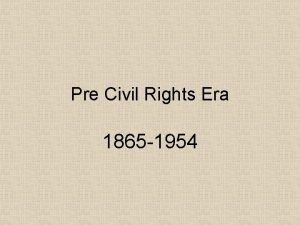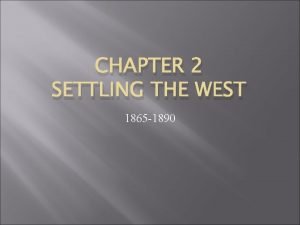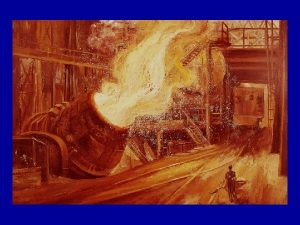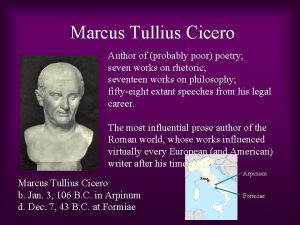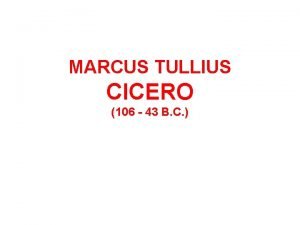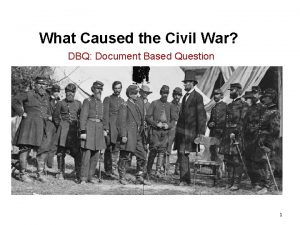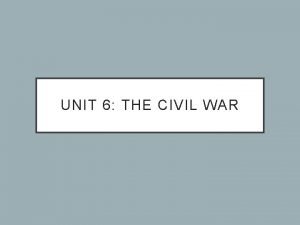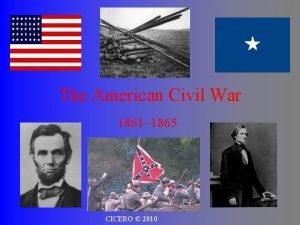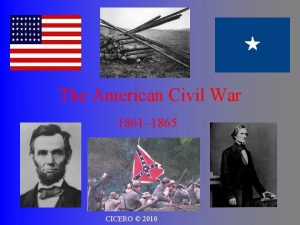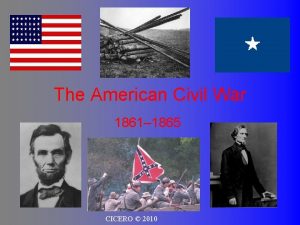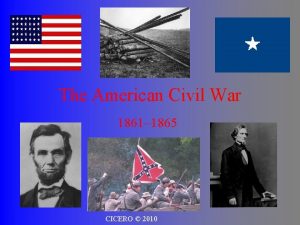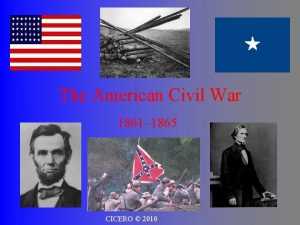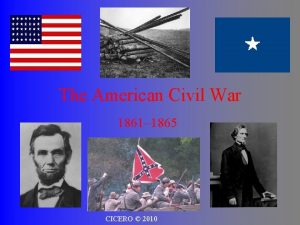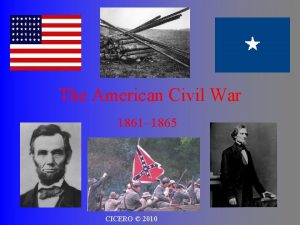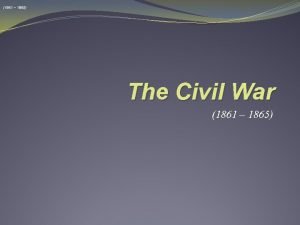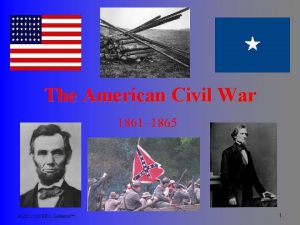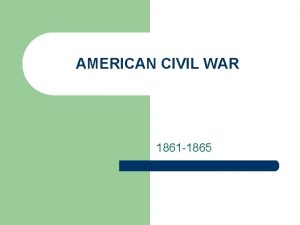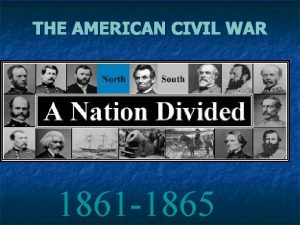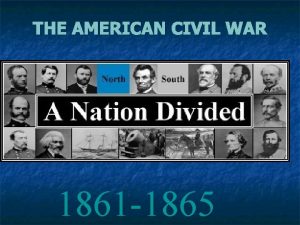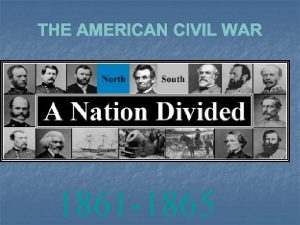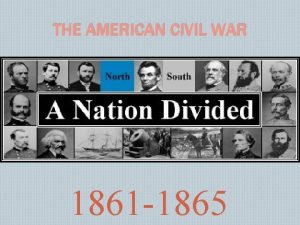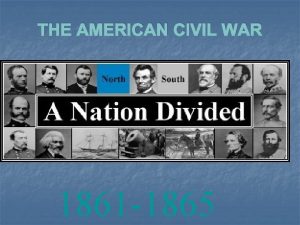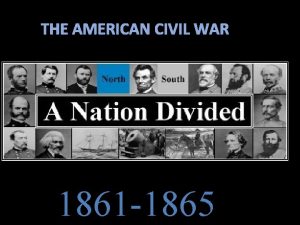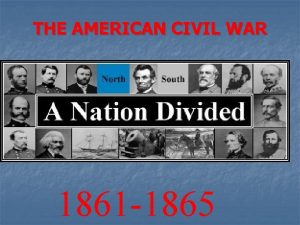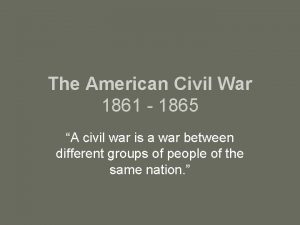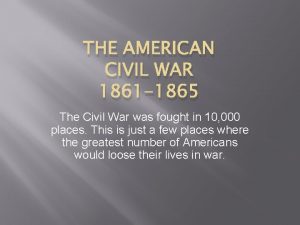The American Civil War 1861 1865 CICERO 2010


















































- Slides: 50

The American Civil War 1861– 1865 CICERO © 2010

Causes There were many causes for the outbreak of the Civil War. Many people agree slavery was the main cause for the war. In addition, sectional differences led to conflicts. Northern and Southern states were developing different lifestyles and cultures. Differences in the economic life of the North and the South also contributed to the conflict. The North’s economy focused on finance and manufacturing, and the South specialized in crops and agricultural trade. Southern states also began to question the extent of the federal government’s power. CICERO © 2010

How does this painting, Tragic Prelude, represent the debate over slavery prior to the Civil War?

Abolitionist Movement The Abolitionist Movement was active in Northern and Western states before the Civil War. Abolitionists wanted slaves to be freed. Some abolitionists favored relocating them in Africa. Many, but not all, abolitionists believed African-American slaves should have the same freedoms as their owners. Southern states opposed the abolition of slavery; it was a financial necessity and part of their social structure. The South’s agricultural trade depended on crops produced with slave labor. CICERO © 2010

A Divided Nation Comparing Northern and Southern Societies The North’s population was three times that of the South. Most other countries recognized the Union as the government in America. However, Britain and France had friendly relations with the Confederacy and considered aiding the South. The North also was more affluent. The South had about nine million people, including about three million slaves. The average Southerner was not as wealthy as the average person living in the North. About 90 percent of American industry and railroads were in the North. Reliance on slave labor discouraged the creation of new jobs in the South. This discouraged immigration, and most immigrants settled in the North. CICERO © 2010

The Leaders Abraham Lincoln was the sixteenth President of the United States. He opposed the expansion of slavery. A Republican, Lincoln led the Union during the Civil War. John Wilkes Booth assassinated Lincoln in Washington, D. C. , on April 14, 1865. Jefferson Davis was President of the Confederate States of America. During the Mexican War, he had been an officer in the United States Army. Davis also had served as the United States Secretary of War. When the South surrendered, he was charged with treason and prohibited from running for public office again. CICERO © 2010

The Generals Ulysses S. Grant Robert E. Lee William T. Sherman Thomas Jackson George Meade James Longstreet George B. Mc. Clellan CICERO © 2010 James E. B. Stuart

The Civil War Begins • The shots fired at Fort Sumter marked the beginning of the Civil War. • In response, Lincoln called for 75, 000 volunteers to serve in the army for 90 days. • The rush to volunteer forced slave states in the South to choose a side. • On April 14, 1861 South Carolina seceded, and on April 17, Virginia followed. • In May, Arkansas, Tennessee, and North Carolina followed.

Uniforms At the beginning of the Civil War, states provided uniforms to soldiers; and the uniforms were in a variety of colors. This led to massive confusion on the battlefield, and often soldiers fired on their own men. As the war continued, both sides chose a single color for their uniforms. The United States of America chose blue, and the Confederate States of America chose gray. CICERO © 2010

Border states choose sides • Border states included: Delaware, Kentucky, Maryland, and Missouri. • Many wondered what the border states would do. • Maryland was the most critical. If it seceded, than Washington D. C. would be surrounded by Confederate territory. • Missouri was important because it controlled the lower Mississippi River.

• Kentucky controlled some 500 miles of the Ohio River. • Both states joined the union.

Goals of the North and South • Northern Goals: Keep the support of the border states and non abolitionists, avoid making slavery the issue, fight to save the Union. • Southern Goals: To be left alone with slavery unchanged.

• The South wanted a defensive war, which meant the North would have to invade the south. • The North was better equipped for the war. • It had a larger population, and contained most of the nation’s factories and railroad lines. • The South was fighting to preserve their way of life. • Some southerners thought the South’s greatest advantage was its huge cotton exports to textile mills in Britain and France.

• The South thought that they would gain foreign aid, but when that did not happen, they stopped exporting cotton to them.

Tactics and Technology • Most of the generals on both sides had been trained at West Point and used tactics that they had learned in previous wars. • The weapons in the Civil War were deadlier than in previous wars. • Other new weapons were exploding shells, flamethrowers, and machine guns. • Observation balloons were used. • The telegraph allowed officers in the field to communicate quickly with government officers.

• For the first time in history, railroads were used to move large numbers of troops and supplies.

Weapons of the Civil War canister shot artillery projectile rifled barrel officer’s sword Springfield rifle, 1861 (Union) Although the Union used many types of rifles, this was the most common. British Enfield rifle, 1853 (Confederacy) minié ball Although the Confederacy used many types of rifles, this was the most common. CICERO © 2010

Union Plans A. Planned to use its Navy to blockade Southern ports. B. Capture the Confederate capitol- Richmond. C. Seize control of the Mississippi River

Confederate Plans A. Fight a defensive war B. Make war unpopular in the North… WHY? C. Trade with Europe for supplies.

Strategies Anaconda Plan Union General Winfield Scott suggested the Anaconda Plan to halt Southern trade. The plan would impose a blockade. This would eventually enable the North to control the Mississippi River. Meanwhile, the army would divide and isolate sections of the South and capture its vital cities and the capital in Richmond, Virginia. Under General Ulysses S. Grant, the North’s strategy kept pressure on General Robert E. Lee’s army and constantly weakened their numbers. The larger population of the North made this possible. King Cotton The Confederacy adopted a defensive strategy and attempted to secure alliances with more powerful countries such as Britain and France. To do that, the South needed to show it could win the war. As a result, the Confederate army attacked Union territory to draw Union troops away from the South and to impress potential allies. As the war continued, the Southern strategy became one of evading the Union army, prolonging the war, and inflicting casualties to demoralize the North. CICERO © 2010

Major Battles of the Civil War • • Fort Sumter First Battle of Bull Run Antietam Fredericksburg Shiloh Chancellorsville Vicksburg Gettysburg

st 1 Battle of Bull Run Where- Bull Run, VA Year- July 21, 1861 Who won- South Generals: South-Stonewall Jackson North-Mc. Clellan Casualties- North-2900 South-2000 WHY IMPORTANT? Showed that both sides needed training and it was going to be a long and bloody war.

Battle of Antietam Year- September 1862 Where- Sharpsburg, Maryland Generals. Robert E. Lee-South Mc. Clellan-North Who won- Nobody, but South retreated. Why important? Bloodiest day of Civil War- 26000 casualties! General Mc. Clellan replaced by Burnside

Battle of Fredericksburg Year- December 1862 Where- Virginia Generals- North. Burnside South-Robert E. Lee Who Won- South killed the North Casualties- Union 13000 Confederacy-5000 Why Important? It was one of the North’s worst defeats, Burnside is retired.

Battle of Shiloh Year- April 1862 Where- Along the Tennessee River Generals. North- Ulysses S. Grant Who Won- North Why Important? One of the bloodiest battles of the Civil war. North Gained control of the Mississippi river. Grant proved himself as a great General.

Battle of Chancellorsville Year- 1863 Where- Virginia Generals. South-Stonewall Jackson Who won- Brilliant victory by the South- again Why important? At the end of one day of battle, nervous Confederate soldiers fired at what they thought was an approaching Union soldierbut is was really Stonewall Jackson- he died several days later.

The War at Sea The Battle of the Ironclads also is known as the Battle of Hampton Roads and the Battle of the Monitor and the Merrimack. This battle was fought off Sewell’s Point near Hampton Roads, Virginia. It was the first naval battle between two ironclad ships, the Union’s USS Monitor and the Confederacy’s CSS Virginia, which was rebuilt from the USS Merrimack. The battle took place over two days, and the Virginia destroyed many of the Union’s wooden ships. The next day, the two ironclads clashed at sea, and the Virginia was damaged. Neither side claimed victory in this battle, but the battle revealed the future of naval warfare. Ironclad, steam-driven ships were at a decisive advantage against wooden sailing vessels. CICERO © 2010

Vicksburg Mississippi May 2 -July 9, 1863 The lengthy Battle of Vicksburg began in Warren County on May 13, 1863. The North and the South considered Vicksburg an important stronghold. Union General Ulysses S. Grant launched massive assaults on Vicksburg and terrorized the inhabitants. Confederates achieved a minimal victory at Milliken’s Bend against untrained black troops. Federal troops pushed Confederate forces back as the size of the Union forces continued to increase. Confederate General John Pemberton surrendered to Grant on July 3, 1863. CICERO © 2010

Gettysburg Pennsylvania July 1 -3, 1863 The Battle of Gettysburg began as the Battle of Vicksburg was ending. Confederate General Lee forced federal troops, under General George C. Meade’s command, to lose ground as the Confederate forces attempted to take the city. Lee planned several attacks, including attacks at Peach Orchard and Devil’s Den. The Union army fought back, repelling Confederate attacks and sending them back to Culp’s Hill. Lee was relentless and sent his army back into battle, but to no avail. He eventually began a retreat toward Williamsport. CICERO © 2010

The Emancipation Proclamation January 1, 1863 President Abraham Lincoln issued the Emancipation Proclamation. It was part of a two-part plan that guaranteed freedom to slaves in the Union and some Confederate states. The Confederate government claimed Lincoln could not issue laws over states in which he had no political control. The first plan, enacted on September 22, 1862, freed slaves in Confederate states that had not yet rejoined the Union. The second part took effect on January 1, 1863, applying to specific states, but not to the border states such as Maryland West Virginia. CICERO © 2010

The Gettysburg Address November 19, 1863 Abraham Lincoln delivered this famous speech on November 19, 1863, to a crowd gathered at the dedication of Soldier’s National Cemetery in Gettysburg, Pennsylvania. The speech contains only two hundred seventy-two words, but it is considered one of the greatest speeches in American history. CICERO © 2010

African Americans and the war • Thousands of slaves, however, escaped to join invading Union troops. • Many were hired to drive wagons, build forts, or serve as guides. • The Emancipation Proclamation freed enslaved people in all areas that were in rebellion against the U. S.

• It encouraged freedmen to join the Union forces. • African American soldiers served in segregated units, usually commanded by white officers. • Nearly 180, 000 African Americans served in the Union armies.

Conditions for soldiers • Most soldiers died not from wounds, but from disease. • They suffered from diseases such as mumps, measles, and smallpox. • Poor sanitation and polluted water also caused diseases. Conditions for prisoners were far worse than in the camps.

• The most notorious prisoner camp was Andersonville in Georgia. • Andersonville. ppt

The Home Front • There was more widespread property damage in the South. • Shortages of both food and goods made life extremely difficult. • Southerners faced inflation. • Military drafts started on both sides, and caused riots across the country.

Women and the War • Women on both sides contributed to the war effort. • Some disguised themselves as men and enlisted in the army. • A few served as spies. • Women took over farms, stores, and businesses. • About 3, 000 served the Union army as nurses.

Clara Barton • Clara Barton served as a nurse and would later begin the American Red Cross.

Blockade Runners • To get scarce goods, southerners depended on blockade runners. • These were low, sleek ships that carried southern cotton to Caribbean ports, where it was unloaded and shipped to Europe. • The ships brought back silk, soap, pepper, and other needed goods. • Later, blockade runners would bring medical and military supplies.

West of the Mississippi • Union and Confederate forces also clashed west of the Mississippi River. • They fought over natural resources and additional soldiers for their armies. • Lincoln did not enforce the draft in the West. • 17, 000 Californians joined the Union army. • Western mines provided gold and silver to pay Union war costs.

• More than 10, 000 Native Americans took part in the Civil War. • Confederate agents negotiated treaties with the Cherokee, Creek, Choctaw, and others. • But many Indian units fought with the Union army.

The Final Phase • In March 1864, Lincoln gave Grant command of all Union armies. • In June, the armies met at the Battle of Cold Harbor • The siege would cut the supplies to the Confederate capital. • Sherman and his army marched toward Atlanta.

• Sherman laid siege to the city and his artillery shelled it daily. • He was able to close the last railroad line into Atlanta.

The election of 1864 • The democrats chose George Mc. Clellan to run as their candidate. • The Republicans chose Lincoln, with Andrew Johnson as his running mate. • Lincoln easily defeated Mc. Clellan in the election. • Lincoln’s victory enabled Congress to finally pass the 13 th Amendment, which ended slavery in the U. S.

The War Ends • After the 1864 election, Sherman and his troops marched across Georgia, and set Atlanta on fire. • Over the next three weeks, Sherman’s army destroyed crops, livestock, homes, and businesses. • In 1865, Confederate forces fled Richmond. • Lee tried to escape but found himself surrounded by Union troops.

• Gone with the Wind clip: Fleeing Atlanta • http: //www. youtube. com/watch? v=Pn. EZr. V _WT 44

• He surrendered rather than lose more lives. • Lee and Grant met at Appomattox Court House, Virginia on April 9. • Lee’s troops had to turn over their weapons and leave. • President Lincoln did not live to see the official end of the war, he would be assassinated three days later on April 14, 1865.

Assassination of Lincoln April 14, 1865 President Abraham Lincoln was assassinated at the end of the Civil War. He was killed on April 14, 1865, while attending a play at Ford’s Theatre in Washington, D. C. , with his wife and two other people. Lincoln was watching Our American Cousin when John Wilkes Booth shot him in the back of the head. Booth was a loyal Confederate, and he thought the Confederacy could triumph if Lincoln were dead. Booth jumped off the balcony and broke his ankle, but managed to escape theater. Lincoln died of his fatal wound the next morning. CICERO © 2010

The Trial and Execution of the Conspirators The conspirators in the assassination of President Lincoln were Mary Surratt, Lewis Powell, David Herold, George Atzerdot, Michael O’Laughlen, Samuel Arnold, Edman Spangler, and Dr. Samuel Mudd. They were tried in a military tribunal court because the government deemed the nature of the case required the use of this court. A majority vote would result in a guilty verdict, while a two-thirds majority would result in a death sentence. All eight were found guilty. Surratt, Powell, Herold, and Atzerdot were sentenced to death by hanging. O’Laughlen died in prison. President Andrew Johnson pardoned Arnold, Spangler, and Mudd. CICERO © 2010

Legacy of the War The Civil War was the bloodiest war in American history. It has been referred to as “The War Between the States, ” “The Brother’s War, ” and the “War of Northern Aggression. ” More than 600, 000 Americans lost their lives, and countless others were wounded severely. The Civil War led to passage of the Thirteenth, Fourteenth , and Fifteen Amendments to the United States Constitution. These amendments outlawed slavery, granted African Americans United States citizenship, and granted African-American males the right to vote. Although equal treatment under the law for African Americans would not be enforced until almost a hundred years later, the Civil War abolished slavery and established the supremacy of the federal government. CICERO © 2010
 Civil war 1861/1862
Civil war 1861/1862 Civil war 1861/1862
Civil war 1861/1862 Regionalism definition literature
Regionalism definition literature Why was the civil war the first modern war
Why was the civil war the first modern war Chapter 16 lesson 2 challenges to slavery
Chapter 16 lesson 2 challenges to slavery Who were abolitionists
Who were abolitionists Indian councils act 1861
Indian councils act 1861 Unionistička stranka 1861
Unionistička stranka 1861 Price v easton (1833)
Price v easton (1833) John brown poster
John brown poster South carolina 1861
South carolina 1861 Springfield model 1861 rifle facts
Springfield model 1861 rifle facts Civil rights and civil liberties webquest
Civil rights and civil liberties webquest Urban america 1865 to 1896
Urban america 1865 to 1896 Hollywood silver fox farm v emmett
Hollywood silver fox farm v emmett The rise of industrial america 1865-1900
The rise of industrial america 1865-1900 Four features of industrial manufacturing (1865-1900)
Four features of industrial manufacturing (1865-1900) 15 th ammendment
15 th ammendment Lesson 1 the rise of industry
Lesson 1 the rise of industry Becoming a world power 1865-1917
Becoming a world power 1865-1917 Impressionism characteristics
Impressionism characteristics Chapter 20 becoming a world power notes
Chapter 20 becoming a world power notes Settling the west 1865 to 1890
Settling the west 1865 to 1890 Gregor mendel 1865
Gregor mendel 1865 How did the term impressionism originate
How did the term impressionism originate 1877-1865
1877-1865 Industrialization (1865 to 1901 worksheet answers key)
Industrialization (1865 to 1901 worksheet answers key) 1865 to 1900 inventions
1865 to 1900 inventions Cicero translation theory
Cicero translation theory Cicero rhetorical devices
Cicero rhetorical devices Cicero poetry
Cicero poetry Marcus cicero 43 bc
Marcus cicero 43 bc Francesca cicero
Francesca cicero Cicero pentagram
Cicero pentagram Cicero seneca
Cicero seneca Cicero prep athletics
Cicero prep athletics Pengertian budaya menurut cicero
Pengertian budaya menurut cicero Cicero umaryland
Cicero umaryland Cicero ui wnd frame
Cicero ui wnd frame Cicero chaves de oliveira paula
Cicero chaves de oliveira paula Marcus tullius cicero publilia
Marcus tullius cicero publilia Caesar and cicero
Caesar and cicero Laodicea karte
Laodicea karte Cicero catilinam denuntiat
Cicero catilinam denuntiat Cicero bibliotekssystem download
Cicero bibliotekssystem download Abacus
Abacus Lazy frog cicero
Lazy frog cicero What caused the civil war dbq
What caused the civil war dbq Civil war map activity
Civil war map activity Civil war causes
Civil war causes Gettysburg gtech
Gettysburg gtech
